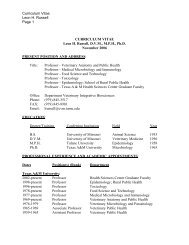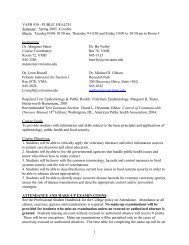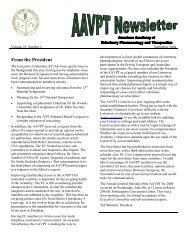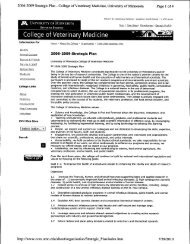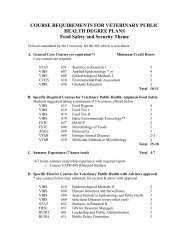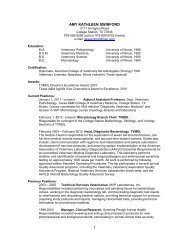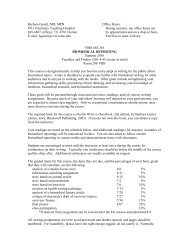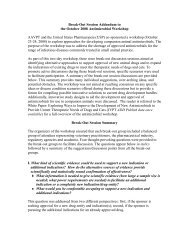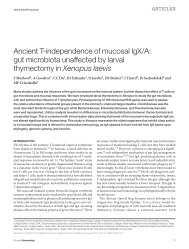Disaster - College of Veterinary Medicine - Texas A&M University
Disaster - College of Veterinary Medicine - Texas A&M University
Disaster - College of Veterinary Medicine - Texas A&M University
You also want an ePaper? Increase the reach of your titles
YUMPU automatically turns print PDFs into web optimized ePapers that Google loves.
It is quite remarkable how important the mentoring<br />
relationship has become within the veterinary pr<strong>of</strong>ession. As<br />
discussed in a previous edition <strong>of</strong> CVM Today, the mentoring<br />
relationship has always been an important aspect <strong>of</strong> our<br />
society demonstrated through apprenticeships, work/study<br />
and shadowing programs, internships, and preceptorships.<br />
There are numerous pr<strong>of</strong>essions, careers and vocations that<br />
depend on mentoring to assist individuals in their training<br />
and aid them in their assimilation into the culture. <strong>Veterinary</strong><br />
medicine is no different. As veterinarians, if we are<br />
able to accomplish excellence in mentoring, we are bound<br />
to attract new faces to our pr<strong>of</strong>ession and our practices, to<br />
recruit and retain individuals to different areas within the<br />
veterinary pr<strong>of</strong>ession, and to share our passion for our pr<strong>of</strong>ession.<br />
Mentorship is one <strong>of</strong> the keys to our pr<strong>of</strong>essional success.<br />
In this edition, we will look at the mentoring contract.<br />
Mentoring is relationship that is as much for our pr<strong>of</strong>essional<br />
development as veterinarians as it is a benefit to those<br />
we mentor. To be a successful mentor requires an intentional<br />
investment <strong>of</strong> time.<br />
Why do some individuals not value investing in the mentoring<br />
relationship? The reasons vary as much as the veterinarians<br />
that make up our pr<strong>of</strong>ession. The reasons include:<br />
not having the time to invest<br />
in a relationship, not believing<br />
they possess the skills, or the<br />
lacking understanding, (due<br />
to their own history), <strong>of</strong> the<br />
value <strong>of</strong> mentorship. However,<br />
by learning a few simple steps,<br />
even the most inexperienced<br />
practitioner can prove to be a<br />
valuable mentor.<br />
Most veterinary students<br />
enter in the educational process<br />
with some level <strong>of</strong> understanding<br />
<strong>of</strong> basic communication,<br />
leadership, and technical skills.<br />
While the educational process<br />
can help develop these skills further, the intentional mentoring<br />
relationship is where they are more finely honed.<br />
The mentor should understand the responsibility <strong>of</strong> transitioning<br />
the new graduate into a pr<strong>of</strong>essional veterinarian.<br />
Upon graduation, the new veterinarian has mainly attained<br />
only entry-level skills. The mentoring relationship is an opportunity<br />
to increase confidence and productivity in a newly<br />
graduated DVM. To be successful, there must be mutual<br />
respect and frequent feedback. Both parties are hoping for a<br />
successful relationship, but it takes more than wishful thinking,<br />
it takes intentional investment. One <strong>of</strong> the ways to fulfill<br />
this in a mentoring relationship is through the “Mentoring<br />
Contract.”<br />
The contract helps make this an intentional process and<br />
not just a haphazard one, and begins with the defining <strong>of</strong><br />
roles and expectations There are four parts to a mentoring<br />
contract:<br />
1) Objectives<br />
2) Schedule<br />
3) Format<br />
4) Evaluation Process<br />
The objectives define what both parties want to achieve<br />
through the mentoring relationship. The objectives need to<br />
be mutually agreed upon by the mentor and mentee because<br />
each individual brings different expectations to the rela-<br />
tionship. These objectives should be the focus <strong>of</strong> the first<br />
scheduled meeting.<br />
The second part <strong>of</strong> the contract is the schedule. By holding<br />
regularly scheduled meetings, we express commitment<br />
to the process. The schedule should be mutually agreed<br />
upon by both parties. Mentor meetings should take place<br />
away from the workplace. If they are pursued within the<br />
walls <strong>of</strong> the workplace, constant interruptions will provide<br />
distractions from the process. Finding time in our busy<br />
schedules is difficult, but a necessity. One way is to schedule<br />
the mentoring meeting around a meal. Breakfast meetings<br />
might work well for some while others enjoy meeting during<br />
lunch or after work. The important aspect is not when we<br />
meet, but that we are meeting on a regular basis. Postponed<br />
meetings are common and can be the death to this<br />
relationship.<br />
In the beginning, the investment <strong>of</strong> time is greater and<br />
more frequent. The first mentoring meeting should be at<br />
least 2–3 hours in length. This meeting is to discuss the<br />
objectives, scheduling time, and format. Recommendations<br />
include: investing one to two hours each week for the first<br />
month <strong>of</strong> the relationship, one to two hours on a biweekly<br />
basis in the second and third month,and at least once<br />
monthly for two hours in the<br />
4th, 5th, and 6th month. Before<br />
a transition in schedule occurs,<br />
the mentor and mentee should<br />
discuss their needs. Many<br />
There are four parts<br />
to a mentoring contract:<br />
times the relationship requires<br />
maintenance and renegotiation<br />
<strong>of</strong> the schedule. Flexibility is<br />
important, so intention can be<br />
maintained.<br />
Another key part <strong>of</strong> the mentoring<br />
contract is the format.<br />
One <strong>of</strong> the common concerns is<br />
what to discuss for long periods<br />
<strong>of</strong> time. In the beginning <strong>of</strong> the<br />
relationship, most <strong>of</strong> the effort<br />
is about getting to know each other. As the individuals work<br />
together, the conversations are shaped by client and staff<br />
interactions, clinical cases, financial aspects <strong>of</strong> the job, projects,<br />
recommendations for individual improvement, and the<br />
development <strong>of</strong> specific technical skill. As trust and mutual<br />
respect are reinforced through this mentor/mentee relationship,<br />
deeper discussions that are focused on personal and<br />
pr<strong>of</strong>essional attributes can be initiated. It is important to<br />
remember each mentor/mentee relationship is different. Encouraging<br />
mutual respect and trust is important in developing<br />
rapport by both parties.<br />
Critical evaluation is the final part <strong>of</strong> the mentoring<br />
contract and is important in building a relationship by mentors<br />
and mentees. Both should ask themselves if they are<br />
mutually receiving what they were expecting. This relationship,<br />
if properly developed, will last for years. The mentoring<br />
relationship doesn’t have to end when there is a pr<strong>of</strong>essional<br />
separation or redirection. I have had the great fortune to ask<br />
advice and receive great counsel from mentors whom I no<br />
longer see on a regular basis. Sometimes they give the best<br />
advice because they have the least amount at stake.<br />
By using this simple contract format and ensuring that expectations<br />
are understood, a relationship based on respect,<br />
trust, and regular communication is fostered. Both the mentor<br />
and the mentee will develop pr<strong>of</strong>essional skills that last a<br />
lifetime.<br />
1) Objectives<br />
2) Schedule<br />
3) Format<br />
4) Evaluation Process<br />
CVM Today • Summer 2010 • 19




